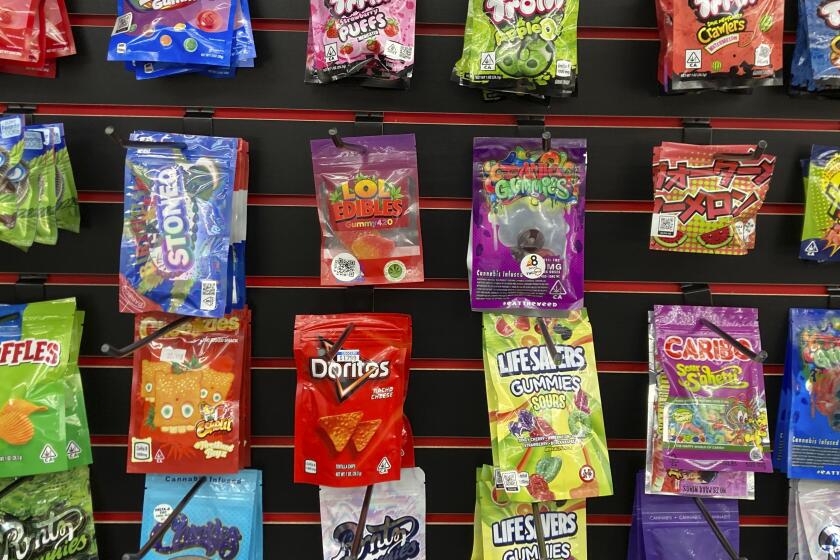California’s proposed DMV rules for driverless cars could change in the wake of federal guidelines
For California state officials, the new federal guidelines on testing and deployment of driverless cars come as a bit of a relief.
Until this week, the absence of U.S. government guidance had left the state Department of Motor Vehicles — generally in charge of registering vehicles and issuing drivers’ licenses — to take the lead role in drafting regulations to ensure the safety of self-driving vehicles.
Though the federal guidelines issued Tuesday are short on specifics, the Department of Transportation will take responsibility for regulating the driving hardware and software, and it has devised a model state policy that probably will take the pressure off individual state agencies.
That policy, issued jointly by the Department of Transportation and the National Highway Traffic Safety Administration, could result in changes to current California draft regulations on autonomous vehicles.
“You can imagine how the California DMV would be struggling, with no technological background or engineers at their disposal, trying to figure out whether a particular autonomous vehicle is or is not safe enough to be deployed,” said Robert Peterson, a law professor at Santa Clara University.
“I expect they will conform their guidelines to the federal guidelines and probably [breathe] a great sigh of relief that they are now off the case,” he said.
Jean Shiomoto, director of the California DMV, confirmed as much. Shiomoto said during a panel discussion Monday that the agency does not have the “expertise on staff” and has relied on NHTSA for guidance and expertise in autonomous vehicle research.
“We’re not experts,” Shiomoto said at a Monday event to discuss the upcoming federal guidelines on autonomous vehicles. “We’re happy NHTSA has come up with guidance documents.”
The 116-page federal policy released Tuesday outlines a “15-point safety assessment” letter that manufacturers and other autonomous vehicle technology entities will be asked to submit to explain how their systems address issues such as vehicle cybersecurity and data collection and storage.
The guidelines also include a model state policy addressing regulation of driverless vehicles. In it, the Department of Transportation states that federal regulations must be followed when a car is driven by software. State laws apply when humans are behind the wheel.
States were given the responsibility of designating a lead agency to govern self-driving vehicle testing and a committee focused on automated safety technology.
States will also be responsible for establishing liability rules for self-driving vehicles and determining which party needs to have motor vehicle insurance — the manufacturer, the owner, the operator, or the passenger.
In 2012, California passed legislation requiring the DMV to adopt driverless vehicle regulations. Two years later, the agency released rules governing the testing of autonomous vehicles on public roads.
So far, 15 companies, including Google, Honda, Tesla and Nissan, hold permits to test driverless vehicles in California.
In December, the DMV released draft regulations for the public deployment of autonomous vehicles. Industry experts described the proposed rules as extremely restrictive; among other things, autonomous vehicles had to be tested by a third-party organization in California and have a driver ready to take the wheel, eliminating the possibility of fully driverless cars.
The DMV said at the time that “subsequent regulatory packages” would address fully autonomous vehicles.
If California decides to adopt the model state policy, it would open the proposed regulations considerably, especially for fully autonomous vehicles, said Peterson of Santa Clara University.
“The federal regulations clearly contemplate the deployment of all levels of cars, when they’re ready,” he said.
On Tuesday, the agency said it would review the federal guidelines and release revised draft regulations for California “in the coming weeks.” A workshop for public input will be held Oct. 20.
“California is an example of the difficulties of regulating and how an effort to encourage and facilitate automated driving has actually complicated and in some ways impeded it,” said Bryant Walker Smith, assistant professor of law and engineering at the University of South Carolina and an affiliate scholar at the Center for Internet and Society at Stanford Law School.
Smith said the model state policy was unlikely to lead to a uniform policy across the country — a point encouraged by the Department of Transportation. But in some cases, custom approaches could work.
“I think it’s OK for states to experiment and see what works,” Smith said. “The kind of patchwork that I think would pose the greater concern is states imposing specific designer requirements on a production vehicle, and that’s what NHTSA would push back against.”
In a statement Tuesday, the DMV said it worked with NHTSA and the American Assn. of Motor Vehicle Administrators to craft the model state policy and that the agency supports NHTSA’s goal of creating a “consistent approach and national framework for the testing and deployment of autonomous vehicles.”
For more business news, follow me @smasunaga
Times staff writer Russ Mitchell contributed to this report.
More to Read
Inside the business of entertainment
The Wide Shot brings you news, analysis and insights on everything from streaming wars to production — and what it all means for the future.
You may occasionally receive promotional content from the Los Angeles Times.










